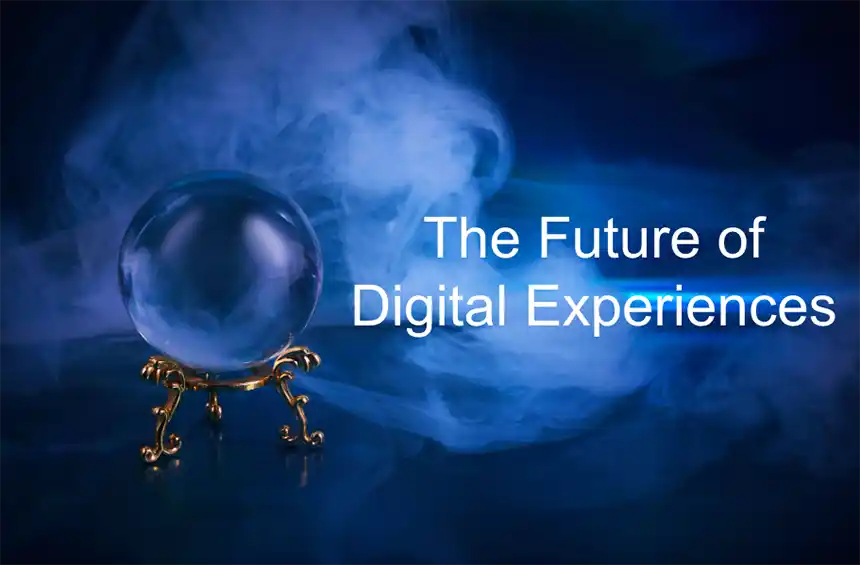The Future of Digital Signage: Latest Trends and Emerging Innovations

Amanda Lee

Digital signage has come a long way since its inception in the early 2000s. Initially used for simple displays of static images and messages, it has evolved into a dynamic and interactive tool for communication and engagement.
As technology advances, the future of digital signage looks promising, especially given that 63% of people have admitted that digital signage is a way to capture their attention.
In this blog post, we will discuss the latest trends and innovations shaping the future of digital signage and explain how brands can use a headless CMS to take advantage of them.
Digital Signage Trends and Innovations
1. Artificial Intelligence and Machine Learning
Artificial intelligence (AI) and machine learning (ML) are revolutionizing how we interact with digital signage. AI and ML enable digital signage to display relevant content based on the audience, weather, time of day, and other contextual factors. This allows for a more personalized and engaging experience for viewers.
For example, digital signage in a retail store can display products and offers based on the customer’s previous purchase history or their current location within the store. AI and ML also enable real-time analysis of viewer behavior and feedback, which can be used to refine the content and improve the overall experience.
2. Interactive Touchscreens
Interactive touchscreens are becoming increasingly popular in the digital signage industry. These touchscreens enable viewers to interact with the content and personalize their experience. They can be used for a range of applications, including wayfinding, product information, and customer service.
Interactive touchscreens can also collect customer data, such as email addresses and feedback, which can help to improve marketing and customer engagement.
3. Internet of Things (IoT)
The rollout of 5G networks and the Internet of Things (IoT) is opening up new possibilities for digital signage. Digital signage can display more dynamic and high-quality content with faster and more reliable connectivity. IoT devices like sensors and beacons can also provide real-time data that helps personalize the content.
For example, a digital signage display in a sports stadium can display live scores and updates based on real-time data from sensors on the field. Similarly, digital signage in a shopping mall can display personalized offers and promotions based on the customer’s location and shopping history.
4. Augmented Reality (AR) and Virtual Reality (VR)
Augmented reality (AR) and virtual reality (VR) are rapidly gaining traction in the digital signage industry. AR and VR enable digital signage to create immersive and interactive viewer experiences. AR can also overlay digital information in the real world, while VR can create fully immersive environments.
For example, digital signage in a museum can use AR to provide additional information and context about exhibits. Similarly, digital signage in a retail store can use VR to create a virtual shopping experience.
5. Sustainability and Energy Efficiency
Sustainability and energy efficiency are increasingly important considerations in the digital signage industry. As the demand for digital signage grows, there is a need to reduce the environmental impact of these displays.
Manufacturers are developing more energy-efficient displays that consume less power and generate less heat. There is also a push toward using more sustainable materials to produce digital signage displays.
6. Omnichannel Connections
Digital signage isn’t only the content channel where customers will want to view content from their favorite brands. With the popularity of mobile devices and applications sky-high, brands must link digital signage to mobile apps via QR codes. Connecting multiple channels in this way will be crucial to creating an omnichannel customer experience.
7. Advertising to Customers on the Go
Customers no longer do most of their brand interactions sitting at their desks. The customer journey isn’t limited to desktops like it might have been a couple of decades ago, yet brands that fail to take advantage of this trend will find themselves missing out.
Digital signage can be used to advertise to customers on the go, for example, by displaying ads for discounted products and sales, not only on billboards in the city but on smaller digital signs outside and on buses with routes near brick-and-mortar stores.
8,. Shoppable Video Ads
A growing trend relevant to digital signage and advertising is the emergence of shoppable video ads. With these shoppable ads, brands can place embedded links or QR codes into videos. Consumers seeing a product they like don’t need to try to figure out what it is but can simply scan the QR code or enter the URL link displayed on a video ad, which then takes them to an e-commerce site where they can purchase it.
9. Driven by a Headless CMS
Headless CMSs enable content to be created, managed, and published on many channels, such as websites, mobile apps, e-commerce experiences, and more. Digital signage is another one of the channels that a headless CMS can drive. In contrast to narrow digital signage solutions, a headless CMS approach enables more flexibility in crafting the digital signage experience for various displays and even smart TVs. It also gives the ability to drive omnichannel experiences across all digital channels that a modern enterprise needs to utilize.
Challenges of Digital Signage Innovation
While the latest trends in digital signage can present numerous opportunities for brands, implementing these trends won’t be possible without overcoming the challenges.
Security and Data Privacy
As with any customer-facing channel that provides content to users, brands need to ensure that security and privacy controls are in place. Both physical devices for digital signage and the CMS software that powers the content for them must have robust security controls to prevent data breaches and exposure to proprietary content or defacing of digital signage.
Screen Compatibility
Digital signs come in all shapes and sizes as each organization’s requirements will be different. Brands must ensure that any solution providing the content for these signs can quickly adapt to different screen sizes and device types.
Accessibility Requirements
Digital signage must be accessible to comply with legal requirements, such as the ADA. That means digital signage content must be available in different formats, and a host of factors, including colors, font sizes, legibility, and more, must be considered to avoid compliance issues.
Personalization Requirements
Personalized content requirements extend to digital signage as well. That means to provide the best quality content experiences to customers using digital signs, brands need access to data about previous customer interactions, preferences, and more for interactive displays and kiosks.
Taking Advantage of Digital Signage Trends With CrafterCMS
Digital signage is a rapidly evolving industry, with new trends and innovations always emerging. As technology continues to advance, the possibilities for digital signage are endless. AI and ML, interactive touchscreens, 5G and IoT, AR and VR, sustainability and energy efficiency, and headless CMS are just a few of the trends shaping the future of digital signage.
The key to success in this industry is staying current with the latest trends and innovations and being willing to adapt to changing customer needs and expectations. You also need a powerful headless CMS to help you take advantage of these trends and overcome the challenges of digital signage.
CrafterCMS is an enterprise-grade headless CMS that offers all the tools for digital signage:
- A best-in-class authoring interface
- The ability to integrate with different tools and technologies via an API-first architecture
- Freedom for developers to choose their preferred technologies
It even provides a truly decoupled architecture where digital signage is completely decoupled from the CMS, which helps to offer improved scalability and security for enterprises.
However, CrafterCMS also offers the ability to produce and deliver engaging video experiences for both live streaming and VOD, build powerful and scalable microsites for specific campaign goals quickly and without the help of IT, increase online sales with personalized, content-rich experiences on eCommerce stores and so much more.
Learn how CrafterCMS empowers digital signage content management by reading: Headless CMS Use Case: Digital Signage.
Related Posts

Navigating the Future of Digital Experiences: A Deep Dive into Emerging Trends

Amanda Jones

Building Personalized Digital Experiences for a Cruise Liner

Sara Williams

CrafterCMS Wins More G2 Awards Spring 2024

Amanda Lee

What Is a Cloud CMS? (Unlocking the Benefits of a CMS in the Cloud)

Sara Williams
Related Resources
-

Personalized Digital Experiences for a Cruise Liner
Webcast
-

Introducing CrafterCMS v4.0
Webcast
-

Modernizing Video Delivery and Content Management at CPAC, A Canadian Nationwide Broadcaster
Webcast
-

Building React Apps on a Headless CMS
White Paper
-

Building OTT Video Experiences with Headless CMS on AWS
White Paper





